Input interpretation

n-phenyl diethanolamine
Chemical names and formulas
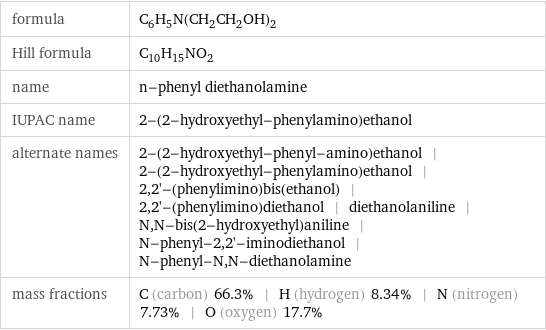
formula | C_6H_5N(CH_2CH_2OH)_2 Hill formula | C_10H_15NO_2 name | n-phenyl diethanolamine IUPAC name | 2-(2-hydroxyethyl-phenylamino)ethanol alternate names | 2-(2-hydroxyethyl-phenyl-amino)ethanol | 2-(2-hydroxyethyl-phenylamino)ethanol | 2, 2'-(phenylimino)bis(ethanol) | 2, 2'-(phenylimino)diethanol | diethanolaniline | N, N-bis(2-hydroxyethyl)aniline | N-phenyl-2, 2'-iminodiethanol | N-phenyl-N, N-diethanolamine mass fractions | C (carbon) 66.3% | H (hydrogen) 8.34% | N (nitrogen) 7.73% | O (oxygen) 17.7%
Lewis structure

Draw the Lewis structure of n-phenyl diethanolamine. Start by drawing the overall structure of the molecule, ignoring potential double and triple bonds: Count the total valence electrons of the carbon (n_C, val = 4), hydrogen (n_H, val = 1), nitrogen (n_N, val = 5), and oxygen (n_O, val = 6) atoms: 10 n_C, val + 15 n_H, val + n_N, val + 2 n_O, val = 72 Calculate the number of electrons needed to completely fill the valence shells for carbon (n_C, full = 8), hydrogen (n_H, full = 2), nitrogen (n_N, full = 8), and oxygen (n_O, full = 8): 10 n_C, full + 15 n_H, full + n_N, full + 2 n_O, full = 134 Subtracting these two numbers shows that 134 - 72 = 62 bonding electrons are needed. Each bond has two electrons, so in addition to the 28 bonds already present in the diagram add 3 bonds. To minimize formal charge carbon wants 4 bonds. Identify the atoms that want additional bonds and the number of electrons remaining on each atom: Fill in the 3 bonds by pairing electrons between adjacent highlighted atoms. Note that the six atom ring is aromatic, so that the single and double bonds may be rearranged: Answer: | |
3D structure
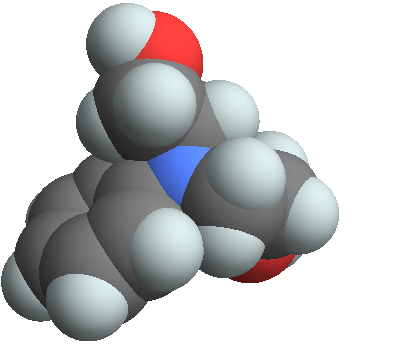
3D structure
Basic properties
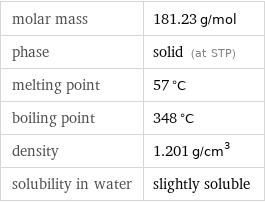
molar mass | 181.23 g/mol phase | solid (at STP) melting point | 57 °C boiling point | 348 °C density | 1.201 g/cm^3 solubility in water | slightly soluble
Units

Solid properties (at STP)

density | 1.201 g/cm^3 vapor pressure | 0.009998 mmHg
Units

Chemical identifiers
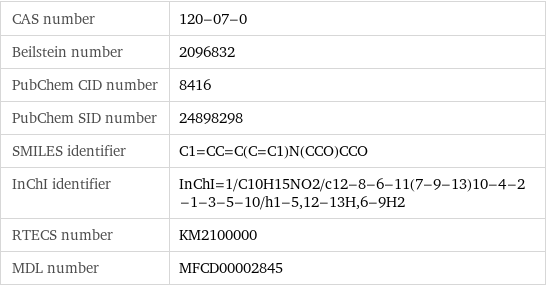
CAS number | 120-07-0 Beilstein number | 2096832 PubChem CID number | 8416 PubChem SID number | 24898298 SMILES identifier | C1=CC=C(C=C1)N(CCO)CCO InChI identifier | InChI=1/C10H15NO2/c12-8-6-11(7-9-13)10-4-2-1-3-5-10/h1-5, 12-13H, 6-9H2 RTECS number | KM2100000 MDL number | MFCD00002845
NFPA label

NFPA label
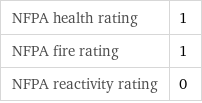
NFPA health rating | 1 NFPA fire rating | 1 NFPA reactivity rating | 0
Safety properties

flash point | 200 °C autoignition point | 380 °C lower explosive limit | 0.7% (concentration in air)
Toxicity properties

RTECS classes | primary irritant